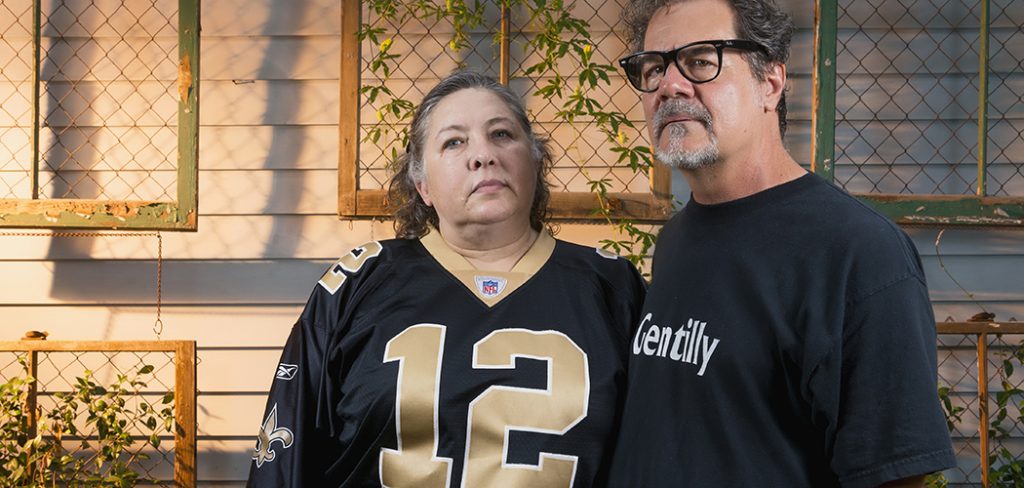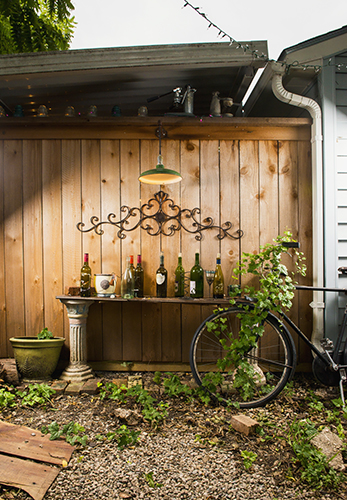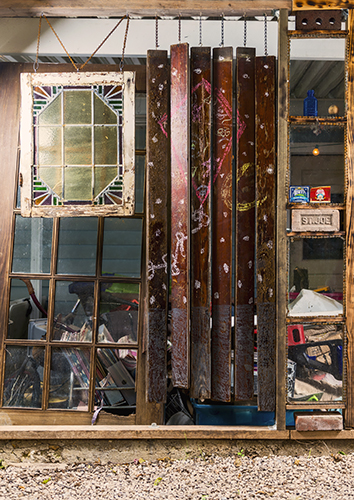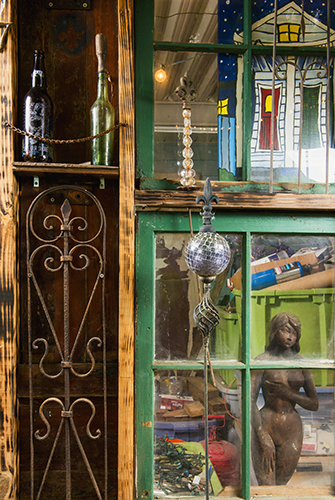
Tiffany and Mark Manson live in Oak Cliff, but New Orleans remains in their hearts. Photo by Danny Fulgencio
When Tiffany and Mark Manson talk about “home,” they don’t mean the house in Oak Cliff, which they renovated and moved into about a year ago. They mean the home they left behind in New Orleans during Katrina, the 2005 hurricane. Katrina ravaged the Gulf Coast, burst through flood walls and washed away neighborhoods across Louisiana and Mississippi, upending innumerable lives and killing almost 2,000.

When Mark and Tiffany Manson finally accepted they weren’t going back to New Orleans, they decided to set down roots by purchasing a home in Dallas. Photo by Danny Fulgencio
That August, Tiffany owned a dog-sitting business in New Orleans and Mark worked in a bicycle shop where he was well known as a mechanic.
Hurricane Katrina wasn’t the first time the government had issued a mandatory hurricane evacuation for New Orleans, but it was the first time Tiffany felt that clench in her gut.
“It happened around Thursday afternoon and Friday morning that my intuition started clicking,” Tiffany says. “We’d never evacuated for a storm, but something told me, ‘We have to go for this one,’ and [Mark] believed me.”
Tiffany suggested visiting her mom in Mesquite for a few days. It would be like a vacation, she said.
It was still dark on Sunday morning when Mark locked the front door on their way out of the city, and it struck him that he might not see home again.
“You have to at least consider it,” Mark says. “It’s always a possibility.”
It wasn’t until they hit Shreveport that the Mansons began listening to the news reports.
“They were talking about a category 5 and 250 mile-per-hour winds, and I started freaking out,” Mark says. “Those 200 miles between Shreveport and Mesquite were terrible. For the first time I was thinking, ‘We’re going to lose everything.’ ”
They arrived at Tiffany’s mom’s house and settled in. Then they heard the storm would not directly hit New Orleans.

Before the Mansons bulldozed their home in New Orleans, they collected windows, doors, floorboards and other pieces, and Mark Manson used the pieces to create a wall in their new backyard. Photo by Danny Fulgencio
Relieved, they went to bed Sunday night only to wake Monday morning to devastating news: Hurricane Katrina’s storm surge had breeched the levees that protected New Orleans from flooding.
“By the time we woke up, our house was already flooded because of where it was,” Tiffany says. “We were on the North side, and all the flooding came from the North.”
Even though they were prepared for the worst, when they saw a satellite image of their home underwater, they were shocked.
They weren’t going home, they realized, at least not anytime soon.
They also couldn’t stay with Tiffany’s mom forever, and they needed to find jobs. The next few weeks were a whirlwind of insurance claims, applying for what little assistance was available and searching for jobs.
One day Mark was in Richardson Bike Mart at White Rock Lake, and he struck up a conversation about cycling with general manager Woody Smith.
When Smith learned Mark was a Katrina evacuee, he asked Mark if he needed a place to stay. Then Smith was quick to offer him a job — a decision he hasn’t regretted.
“He’s a great, great employee,” Smith says. “I think the world of him. He has a lot of knowledge about bikes, and he loves people.”
During the transition, people within the cycling community in Dallas embraced the Mansons, ready to help in whatever way possible.
“(Woody) was very willing to help us,” Mark says. “I told him, ‘Look, it’s only going to be for a couple of months. I’ll sweep the floor or whatever you need.’ He said, ‘No, we’ll set you guys up.’ They were great.
“The owner of the company was going to Italy with his wife, and he said, ‘If you need a place to stay, you can stay at our house. If you need a truck, we’re not going to be driving ours.’ I’d never met him. It was just unbelievable, and that’s when I really started to feel like, OK, things are going to be good here.”

Before the Mansons bulldozed their home in New Orleans, they collected windows, doors, floorboards and other pieces, and Mark Manson used the pieces to create a wall in their new backyard. Photo by Danny Fulgencio
They moved into an apartment and later into a house on Lower Greenville. It was the closest thing to New Orleans they could find.
“There were multiple gossiping sessions that happened in the middle of the street between neighbors,” Tiffany says. “The neighbors would host a quinceañera, and everyone would bring food.”
Mark could ride his bike to work. They found a favorite local hangout. They connected with fellow New Orleans Saints fans.
Seeing their home for the first time after the flood was surreal. It was like the whole city was covered in a grey film.
“It was like watching a black-and-white film out your car window,” Tiffany says. “Not muddy brown. Grey. And the smell was unlike anything you could ever describe. It was a mixture of chemicals and mold and death.”
Their street was empty. No one was around. There were not even birds, and the silence was eerie.
“We didn’t even speak,” Mark says. “We were just driving in silence.”
They pulled up to their house with a sense of “morbid curiosity,” Mark says. They wanted to see it and didn’t at the same time.
The number of things the couple was able to save could be counted on one hand — a piece of fine art, a handmade cabinet from Mark’s great-grandfather and a full set of Depression glass. Not one photo. No clothes. No mementos.
They couldn’t afford to gut their old home until about a year after the hurricane. Even then, their neighborhood was still in bad shape.
“It’s a blue-collar neighborhood that’s still not rebuilt completely,” Tiffany says. “The neighborhoods with all the money, they were rebuilt the fastest. People provided the poor neighborhoods with the resources to rebuild. The people in our neighborhoods who have always worked, we all went somewhere else to get jobs and couldn’t come home. We fell through the cracks.”
For years, they told themselves they would go back. They belong in their city.
“But we were just kidding ourselves,” Mark says. The New Orleans they knew was gone.
Besides, their life in Dallas was pretty good. Richardson Bike Mart promoted Mark to manager and Tiffany’s pet-sitting business took off.
They finally bulldozed their home in New Orleans because the property was worth more without it, but they salvaged a few parts — doors, windows and hardwood flooring.
They love their Oak Cliff neighbors and Mark has been using parts from the old house to build a memorial for New Orleans in their backyard.
“It’s functional as a wall, but it’s more like an art piece,” he says. “I’m not an artist by any means, but I like the symbolism. I want to finish it by the anniversary, but it’s a work in progress. So that has been really healing.”




